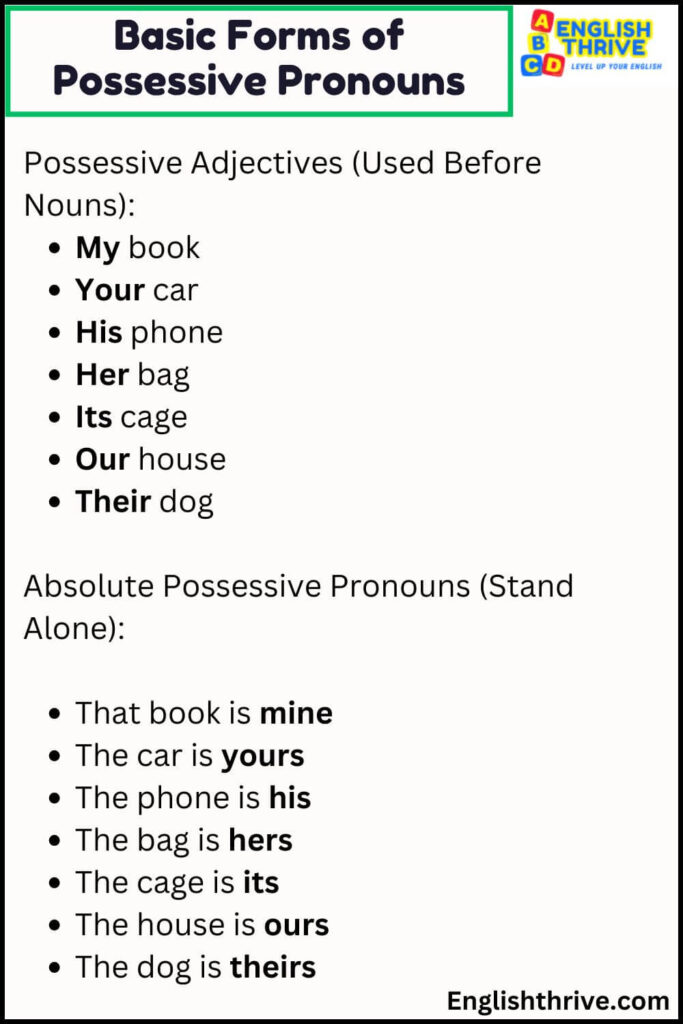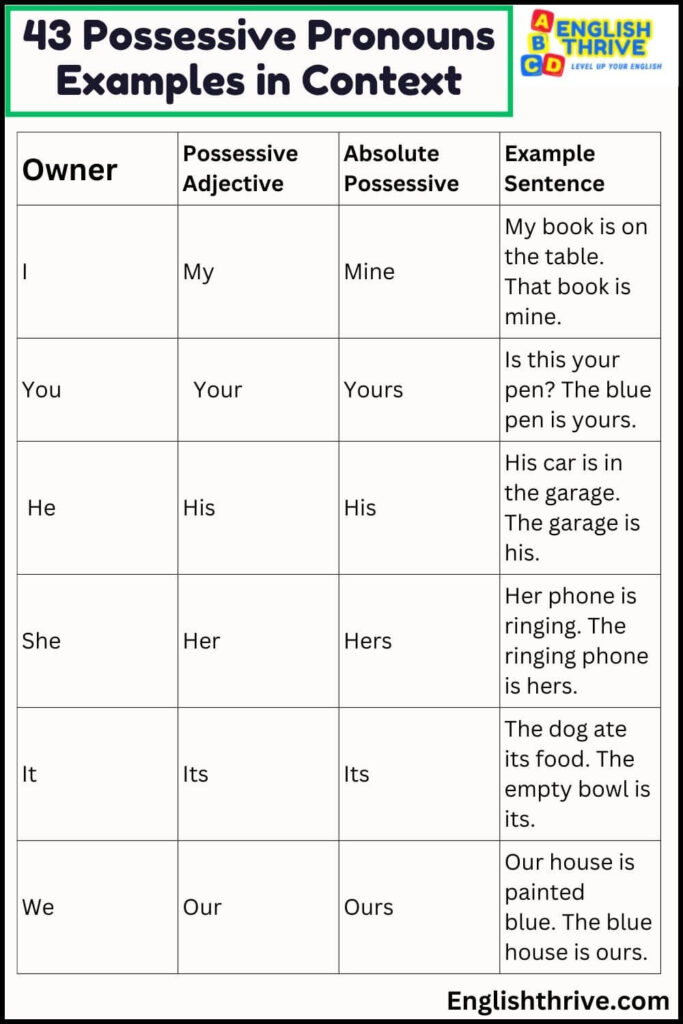Ever mixed up “your” and “you’re” in a text? Or wondered whether to use “its” or “it’s” in an email? You’re not alone! Understanding possessive pronouns can be tricky, but I’m here to help. Let’s explore 43 possessive pronouns examples that will clear up any confusion and make your writing stronger. With these examples and simple rules, you’ll master possessive pronouns in no time.
Contents
ToggleWhat Are Possessive Pronouns?
Possessive pronouns show ownership or belonging. Think of them as the words that answer the question “Whose is it?” They come in two forms: possessive adjectives (my, your, his, her, its, our, their) and absolute possessive pronouns (mine, yours, his, hers, its, ours, theirs).
 possessive pronouns examples
possessive pronouns examples
Basic Forms of Possessive Pronouns
Possessive Adjectives (Used Before Nouns):
- My book
- Your car
- His phone
- Her bag
- Its cage
- Our house
- Their dog
Absolute Possessive Pronouns (Stand Alone):
- That book is mine
- The car is yours
- The phone is his
- The bag is hers
- The cage is its
- The house is ours
- The dog is theirs
Rules for Using Possessive Pronouns Examples
Before Nouns vs. Standing Alone
- Use possessive adjectives before nouns: “My car is red”
- Use absolute possessive pronouns alone: “The red car is mine“
No Apostrophes Needed
- Possessive pronouns never use apostrophes
- “Its” (possessive) vs. “it’s” (contraction of “it is”)
Agreement Rules
- Match the pronoun to the owner’s number and gender
- Single owner = singular pronoun
- Multiple owners = plural pronoun
43 Possessive Pronouns Examples
| Owner | Possessive Adjective | Absolute Possessive | Example Sentence |
|---|---|---|---|
| I | My | Mine | My book is on the table. That book is mine. |
| You | Your | Yours | Is this your pen? The blue pen is yours. |
| He | His | His | His car is in the garage. The garage is his. |
| She | Her | Hers | Her phone is ringing. The ringing phone is hers. |
| It | Its | Its | The dog ate its food. The empty bowl is its. |
| We | Our | Ours | Our house is painted blue. The blue house is ours. |
| They | Their | Theirs | Their bikes are red. The red bikes are theirs. |
| I | My | Mine | My laptop needs repair. The broken laptop is mine. |
| You | Your | Yours | Your work is excellent. The excellent work is yours. |
| He | His | His | His grades improved. The improved grades are his. |
| She | Her | Hers | Her garden is beautiful. The beautiful garden is hers. |
| It | Its | Its | The cat caught its toy. The caught toy is its. |
| We | Our | Ours | Our team won. The winning team is ours. |
| They | Their | Theirs | Their project succeeded. The successful project is theirs. |
| I | My | Mine | My keys are lost. The lost keys are mine. |
| You | Your | Yours | Your seat is reserved. The reserved seat is yours. |
| He | His | His | His office is upstairs. The upstairs office is his. |
| She | Her | Hers | Her art is unique. The unique art is hers. |
| It | Its | Its | The printer lost its connection. The lost connection is its. |
| We | Our | Ours | Our decision is final. The final decision is ours. |
| They | Their | Theirs | Their success is impressive. The impressive success is theirs. |
 possessive pronouns examples
possessive pronouns examples
FAQs about Possessive Pronouns Examples With Clear Rules
1. How do you identify possessive pronouns in a sentence?
To identify possessive pronouns, look for words that show ownership. They come in two forms:
- Words that come before nouns (my, your, his, her, its, our, their)
- Words that stand alone (mine, yours, his, hers, its, ours, theirs)
For example, in the sentence “That book is mine,” “mine” is a possessive pronoun because it shows ownership of the book. In “My book is here,” “my” is a possessive adjective showing ownership of the book.
2. What’s the difference between possessive pronouns and possessive adjectives?
The main difference lies in how they’re used in sentences:
- Possessive adjectives (my, your, his, her, its, our, their) always come before nouns
- Possessive pronouns (mine, yours, his, hers, its, ours, theirs) stand alone
Example:
- Possessive adjective: “This is my car.”
- Possessive pronoun: “This car is mine.”
3. When should you use ‘its’ vs ‘it’s’?
This is one of the most common confusions in English. Here’s the simple rule:
- Its (no apostrophe) = possessive form
- It’s (with apostrophe) = contraction of “it is” or “it has”
Examples:
- The dog wagged its tail. (possessive)
- It’s raining outside. (it is)
4. How do possessive pronouns work with compound subjects?
When dealing with compound subjects, follow these rules:
- Use singular possessive pronouns for individual ownership
- Use plural possessive pronouns for shared ownership
Examples:
- “Tom and Jerry each have their own rooms.” (separate ownership)
- “Tom and Jerry share their apartment.” (shared ownership)
5. Can possessive pronouns be used with gerunds?
Yes, possessive pronouns can be used with gerunds (verbs ending in -ing that function as nouns). In fact, it’s often preferred:
- Correct: “They didn’t like my singing.”
- Also correct: “They didn’t like me singing.”
- Less formal: “They didn’t like me sing.”
Conclusion
Understanding possessive pronouns examples doesn’t have to be complicated. Remember the basic rules: possessive adjectives come before nouns, while absolute possessive pronouns stand alone. Practice using these forms in your daily writing and speaking, and you’ll find they become natural tools for expressing ownership clearly and correctly. Keep this guide handy as a reference while you continue improving your grammar skills.

